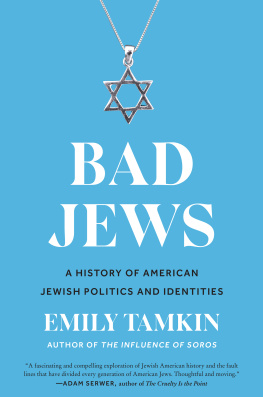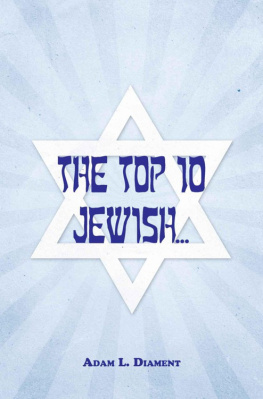
Why the Jews?
Published by Rowman & Littlefield
An imprint of The Rowman & Littlefield Publishing Group, Inc.
4501 Forbes Boulevard, Suite 200, Lanham, Maryland 20706
www.rowman.com
6 Tinworth Street, London SE11 5AL, United Kingdom
Copyright 2021 by The Rowman & Littlefield Publishing Group, Inc.
All rights reserved. No part of this book may be reproduced in any form or by any electronic or mechanical means, including information storage and retrieval systems, without written permission from the publisher, except by a reviewer who may quote passages in a review.
British Library Cataloguing in Publication Information Available
Library of Congress Cataloging-in-Publication Data
ISBN: 978-1-5381-4312-4 (cloth)
ISBN: 978-1-5381-4313-1 (electronic)
 The paper used in this publication meets the minimum requirements of American National Standard for Information SciencesPermanence of Paper for Printed Library Materials, ANSI/NISO Z39.48-1992.
The paper used in this publication meets the minimum requirements of American National Standard for Information SciencesPermanence of Paper for Printed Library Materials, ANSI/NISO Z39.48-1992.

Contents
Guide

I have been an economist writing on public policy for more than forty years, focusing on issues related to race and poverty. Along the way, I studied the Jewish immigrant experience and the persistence of anti-Semitic barriers. I included some of this material in my 1989 book, Discrimination: Its Economic Impact on Blacks, Women, and Jews.
An important reason for my inclusion of the Jewish experience is that I am Jewish. I grew up in 1950s Brooklyn and graduated Madison High School one year after Bernie Sanders. Like him, I was raised in a family that had experienced anti-Semitism, not in Europe but in the United States. We were not religiouswe never went to synagogue, even on Rosh Hashanah and Yom Kippurbut when the High Holy Days came, we dressed in our Sunday best and stayed home from work and school. This was my mothers response to the anti-Semitism she had experienced during the Depression, when some employers fired Jewish workers who took time off to observe these holidays.
Like many Jewish youth in the 1950s, I thought twice before venturing into Irish neighborhoods, intimidated by the prospect of being taunted and roughed up by Gentile boys. Even during my first years at Cornell in the early 1960s, there was a whiff of hatred in the air, a reaction to the growing Jewish presence on the campus. Like Sanders, in the 1960s I was led to radical politics by these working-class concerns, but unlike him, I did not abandon my Jewishness, especially after I married a child of Holocaust survivors.
When my two children came to bar and bat mitzvah age, I enrolled them in a kindershul, a remnant of the Jewish left-wing cultural milieu that thrived before the Second World War. There, not only my children but I too received an education on the important role that Jews had played in the civil rights and labor movements. Over time, I also became intrigued by the Jewish role in the making of American popular culture. This interest was brought to the foreground after I read Gablers An Empire of Their Own: How the Jews Invented Hollywood, a book I stumbled upon in the library of a cruise ship during our annual family vacation.
Gabler told the stories of the first-generation Jewish movie moguls, in particular how theyd wrested control of the moviemaking industry from the WASP forces, led by Thomas Edison, that had gained a monopoly position during the first decade of the twentieth century. What intrigued me was that these were uneducated Jews, just like my own extended family. They especially reminded me of my favorite uncle Willie, who had been a driver for Jewish mobsters in Brooklyn in the 1930s. When I thought about it, I realized that Milton Berle, Groucho Marx, Eddie Cantor, and so many other Jewish comedians Id seen on TV or on stage during the few summers we could afford to vacation in a Catskills bungalow colony were the children of uneducated immigrants as well.
I strongly disagreed with Gablers insistence that these Hollywood moguls had strived to escape their Jewishness. The Jewish men and women in my working-class family had longed to be integrated into the American mainstream no less than the movie moguls. My family and our Jewish neighbors also eschewed religious observance but almost none of them rejected their Jewishness. They bought kosher meat, they had their sons bar mitzvahed, and virtually all of their friends were Jewish. If this was true for the postwar generation, it must have been all the more so during the first decades of the twentieth century!
As a Jew and a social scientist, I became obsessed with both the narrative and mystery of the Jewish takeover of American mass culture. It seemed to me that Judaism in general, but especially the Eastern European variant, brought something new to the table, and that was its embrace of an uncritical appreciation of the importance of bodily pleasure to human happiness. At the turn of the century, this stood in stark contrast to mainstream Christianity, whether it was Victorian Protestantism or the Augustinian understanding of congenital sinfulness that dominated Irish Catholic teachings. This line of thinking led me to spend more time than I ever expected studying Christian and Talmudic beliefs on bodily pleasure as they evolved during the first four centuries of the Common Era, as well as the contrasting seventeenth- and eighteenth-century Irish Catholic and Hasidic views on the subject. Indeed, these readings let to my publishing Jewish and Christian Views on Bodily Pleasure (Wipf & Stock, 2018).
I had also published an article, Jewish Displacement of Irish Americans in Vaudeville: The Role of Religious and Cultural Values, in the Journal of Religion and Popular Culture in 2013, which documented the role of religious values in explaining Jewish dominance in vaudeville and silent films during the first two decades of the twentieth century. As the book moved further into the twentieth century, however, there were other influences that were responsible for the continued dominant role of Jews. However, this books main point remained: Jewish cultural and religious values were central to understanding Jewish involvement and success in popular culture industries throughout the twentieth century.

During the first decade of the twentieth century, the major vaudeville venues were part of the national theater chain controlled by Benjamin Franklin Keith and Edward Franklin Albee. Led by Thomas Edison, the Motion Picture Patents Company held exclusive rights to Kodaks motion picture film stock and key patents on projection equipment, giving it control of virtually every silent movie legally produced in the United States. However, Jewish audiences, entrepreneurs, and entertainers broke these Protestant strangleholds.
In vaudeville, Jewish performers eclipsed Irish performers and Jewish entrepreneurs undermined the Keith-Albee monopoly. In the silent film industry, Jewish moguls gained control of all the major silent film studios. By the 1930s, the movie industry was a Jewish club behind the scenes: Jewish talent agencies represented actors, Jewish lawyers negotiated their contracts, and Jewish writers wrote their dialogue. F. Scott Fitzgerald bitterly characterized Hollywood as a Jewish holiday, a Gentiles tragedy.
Next page








 The paper used in this publication meets the minimum requirements of American National Standard for Information SciencesPermanence of Paper for Printed Library Materials, ANSI/NISO Z39.48-1992.
The paper used in this publication meets the minimum requirements of American National Standard for Information SciencesPermanence of Paper for Printed Library Materials, ANSI/NISO Z39.48-1992.